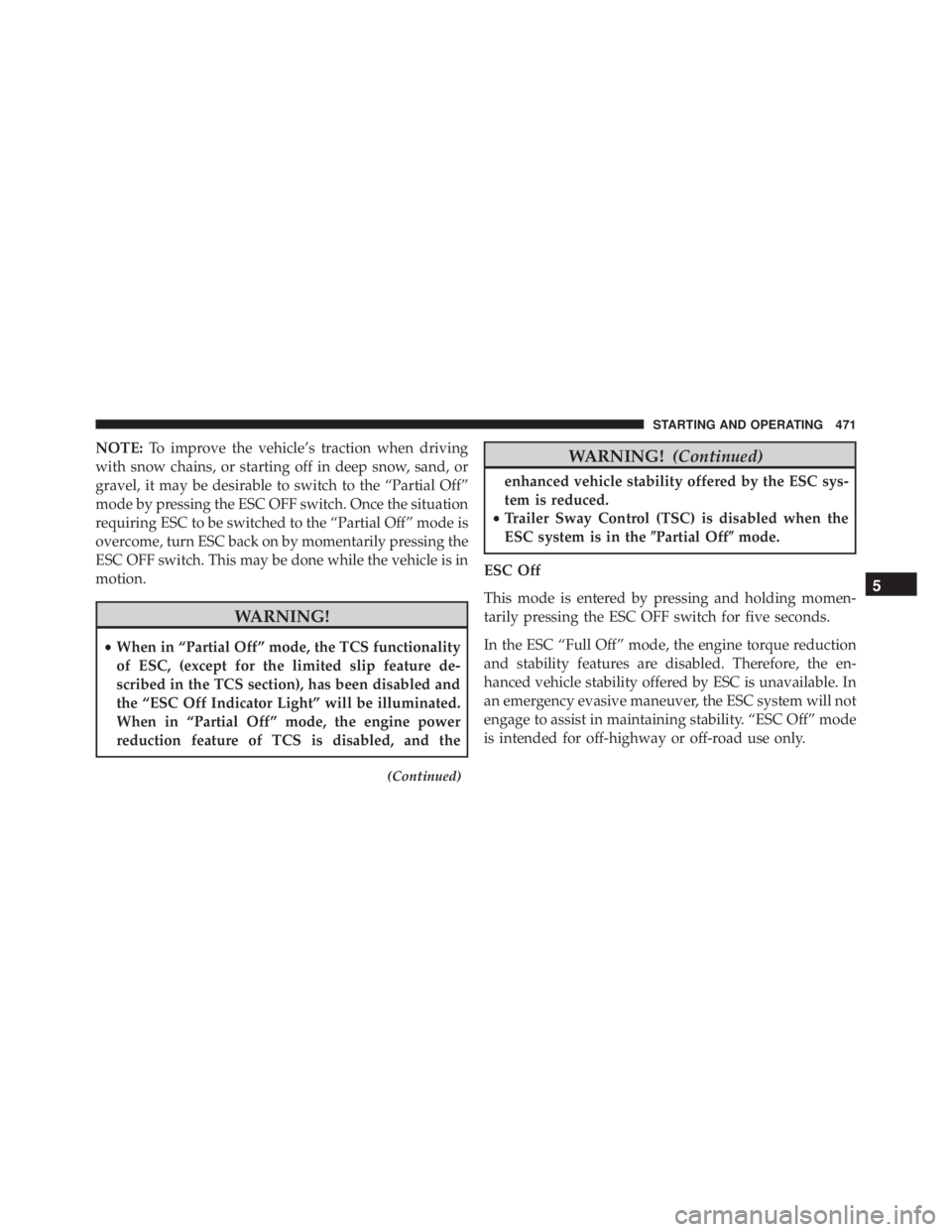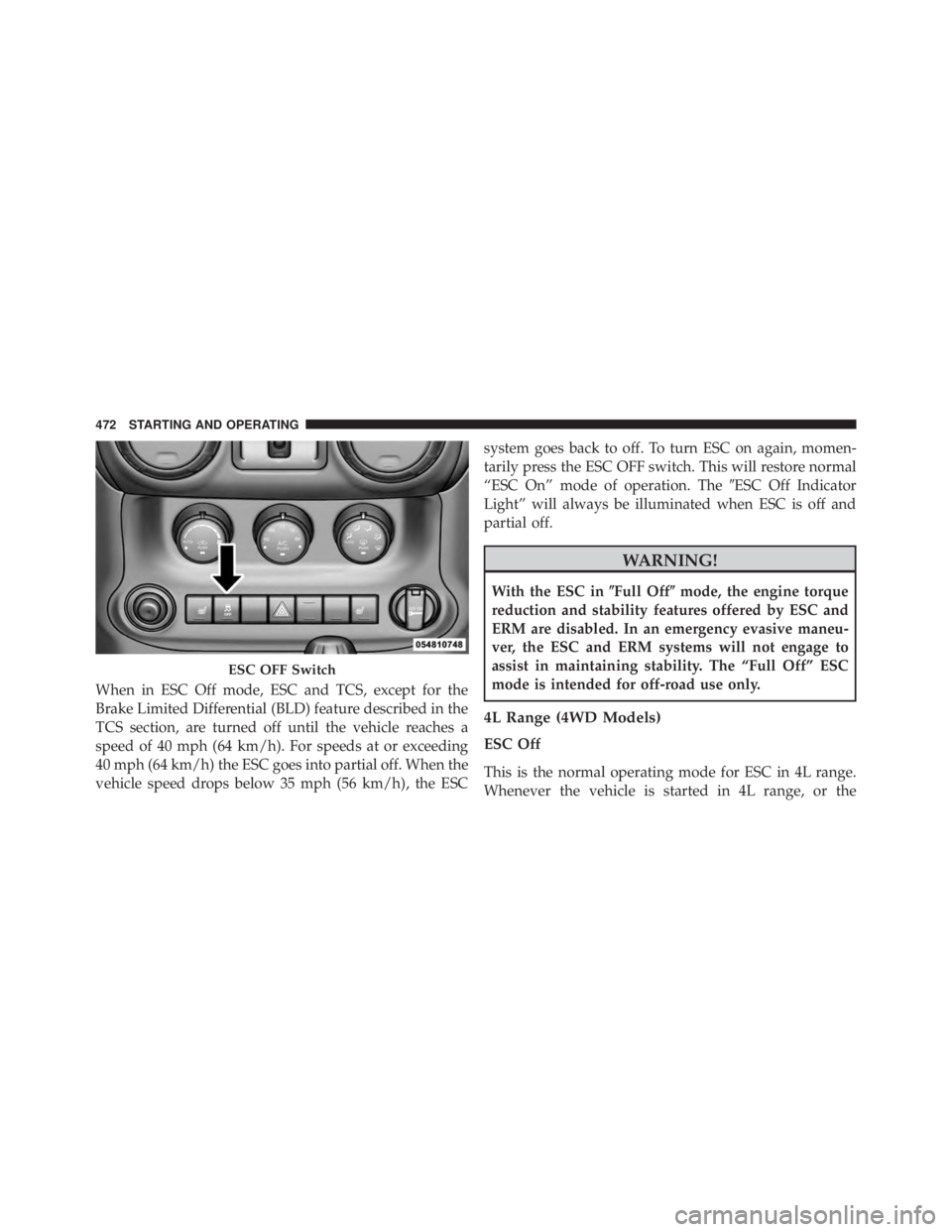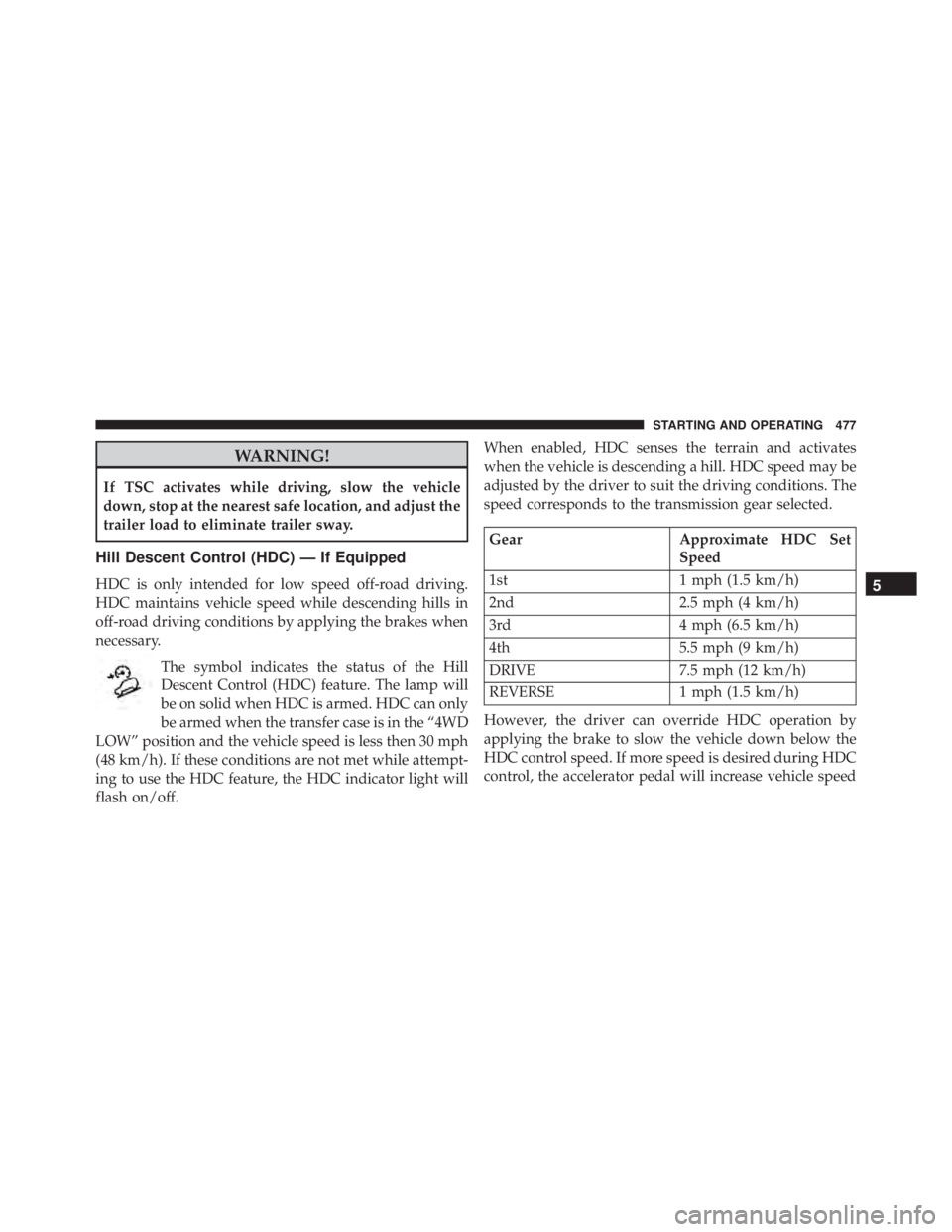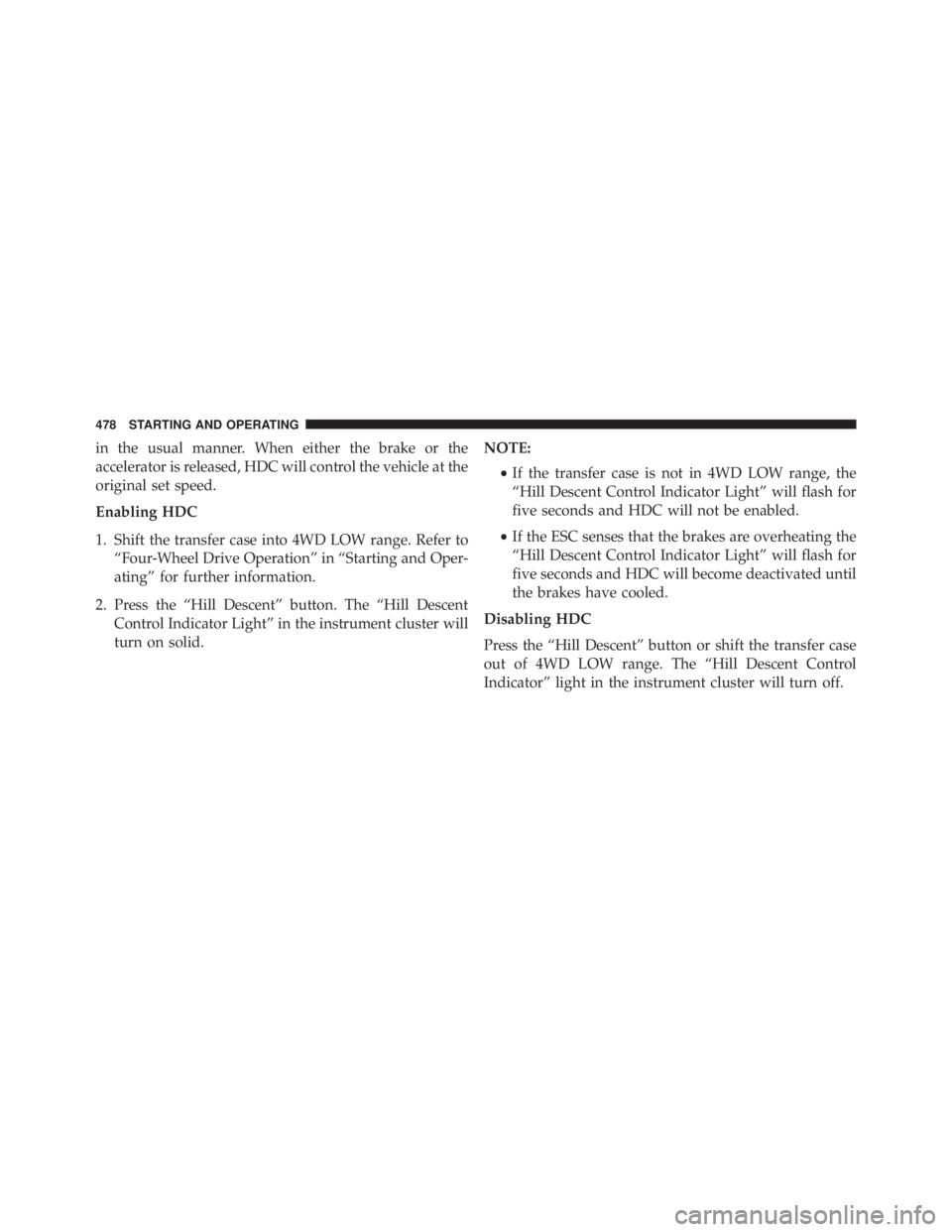JEEP WRANGLER UNLIMITED SAHARA 2014 Owners Manual
WRANGLER UNLIMITED SAHARA 2014
JEEP
JEEP
https://www.carmanualsonline.info/img/16/56077/w960_56077-0.png
JEEP WRANGLER UNLIMITED SAHARA 2014 Owners Manual
Trending: lock, automatic transmission, brake rotor, child seat, change wheel, center console, radiator cap
Page 471 of 674
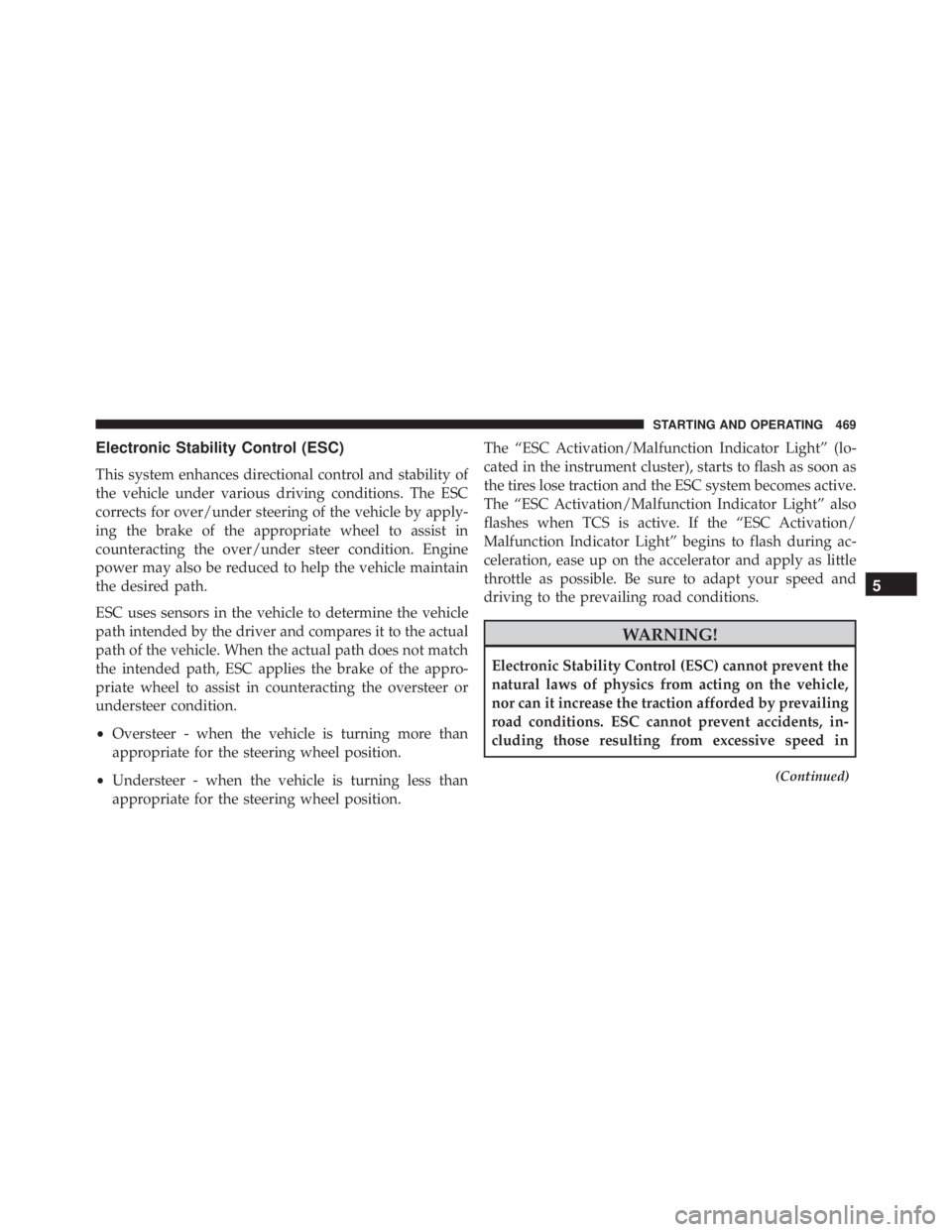
Electronic Stability Control (ESC)
This system enhances directional control and stability of
the vehicle under various driving conditions. The ESC
corrects for over/under steering of the vehicle by apply-
ing the brake of the appropriate wheel to assist in
counteracting the over/under steer condition. Engine
power may also be reduced to help the vehicle maintain
the desired path.
ESC uses sensors in the vehicle to determine the vehicle
path intended by the driver and compares it to the actual
path of the vehicle. When the actual path does not match
the intended path, ESC applies the brake of the appro-
priate wheel to assist in counteracting the oversteer or
understeer condition.
•Oversteer - when the vehicle is turning more than
appropriate for the steering wheel position.
• Understeer - when the vehicle is turning less than
appropriate for the steering wheel position. The “ESC Activation/Malfunction Indicator Light” (lo-
cated in the instrument cluster), starts to flash as soon as
the tires lose traction and the ESC system becomes active.
The “ESC Activation/Malfunction Indicator Light” also
flashes when TCS is active. If the “ESC Activation/
Malfunction Indicator Light” begins to flash during ac-
celeration, ease up on the accelerator and apply as little
throttle as possible. Be sure to adapt your speed and
driving to the prevailing road conditions.
Page 472 of 674
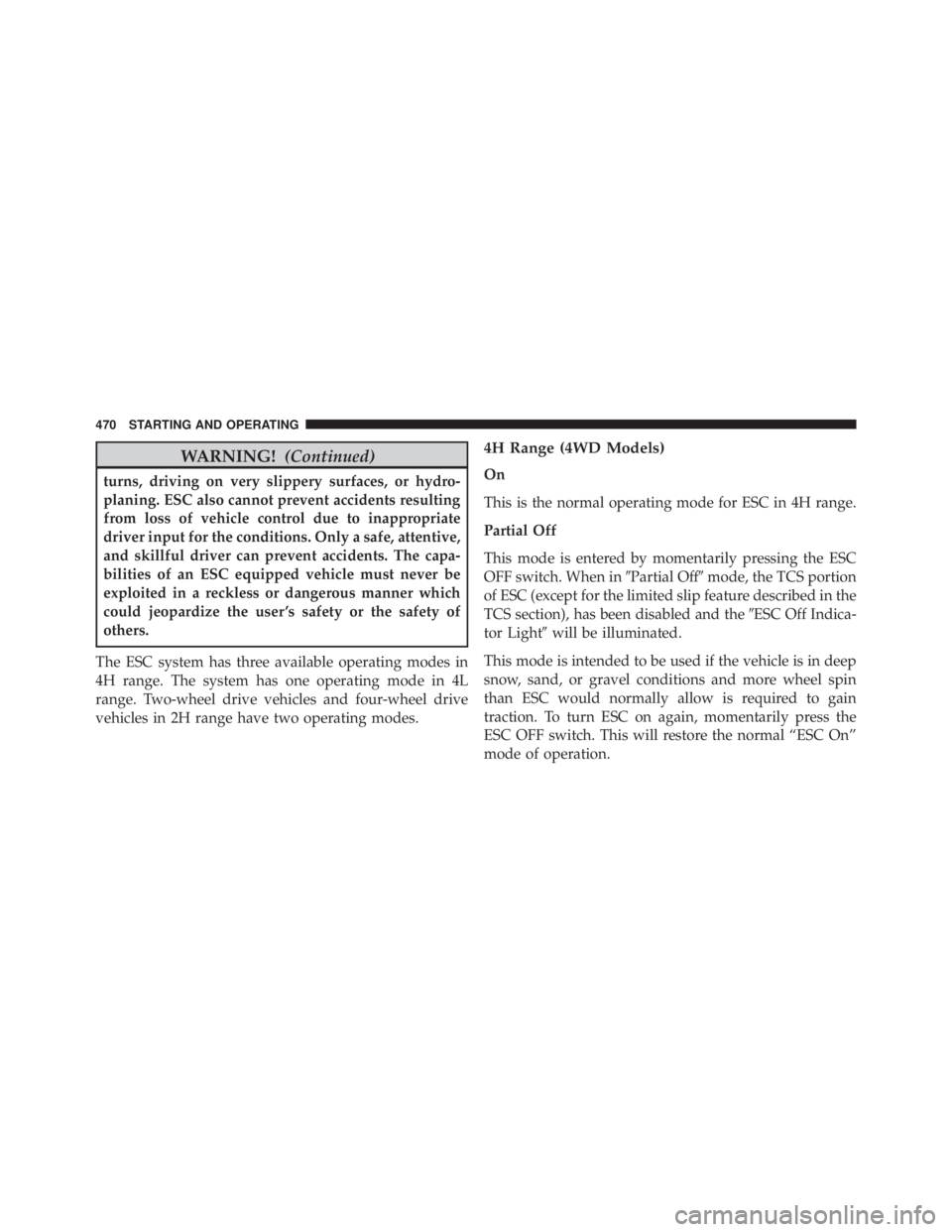
WARNING!(Continued)
turns, driving on very slippery surfaces, or hydro-
planing. ESC also cannot prevent accidents resulting
from loss of vehicle control due to inappropriate
driver input for the conditions. Only a safe, attentive,
and skillful driver can prevent accidents. The capa-
bilities of an ESC equipped vehicle must never be
exploited in a reckless or dangerous manner which
could jeopardize the user ’s safety or the safety of
others.
The ESC system has three available operating modes in
4H range. The system has one operating mode in 4L
range. Two-wheel drive vehicles and four-wheel drive
vehicles in 2H range have two operating modes.
4H Range (4WD Models)
On
This is the normal operating mode for ESC in 4H range.
Partial Off
This mode is entered by momentarily pressing the ESC
OFF switch. When in �Partial Off�mode, the TCS portion
of ESC (except for the limited slip feature described in the
TCS section), has been disabled and the �ESC Off Indica-
tor Light� will be illuminated.
This mode is intended to be used if the vehicle is in deep
snow, sand, or gravel conditions and more wheel spin
than ESC would normally allow is required to gain
traction. To turn ESC on again, momentarily press the
ESC OFF switch. This will restore the normal “ESC On”
mode of operation.
470 STARTING AND OPERATING
Page 473 of 674
NOTE:To improve the vehicle’s traction when driving
with snow chains, or starting off in deep snow, sand, or
gravel, it may be desirable to switch to the “Partial Off”
mode by pressing the ESC OFF switch. Once the situation
requiring ESC to be switched to the “Partial Off” mode is
overcome, turn ESC back on by momentarily pressing the
ESC OFF switch. This may be done while the vehicle is in
motion.
Page 474 of 674
When in ESC Off mode, ESC and TCS, except for the
Brake Limited Differential (BLD) feature described in the
TCS section, are turned off until the vehicle reaches a
speed of 40 mph (64 km/h). For speeds at or exceeding
40 mph (64 km/h) the ESC goes into partial off. When the
vehicle speed drops below 35 mph (56 km/h), the ESCsystem goes back to off. To turn ESC on again, momen-
tarily press the ESC OFF switch. This will restore normal
“ESC On” mode of operation. The
�ESC Off Indicator
Light” will always be illuminated when ESC is off and
partial off.
Page 475 of 674
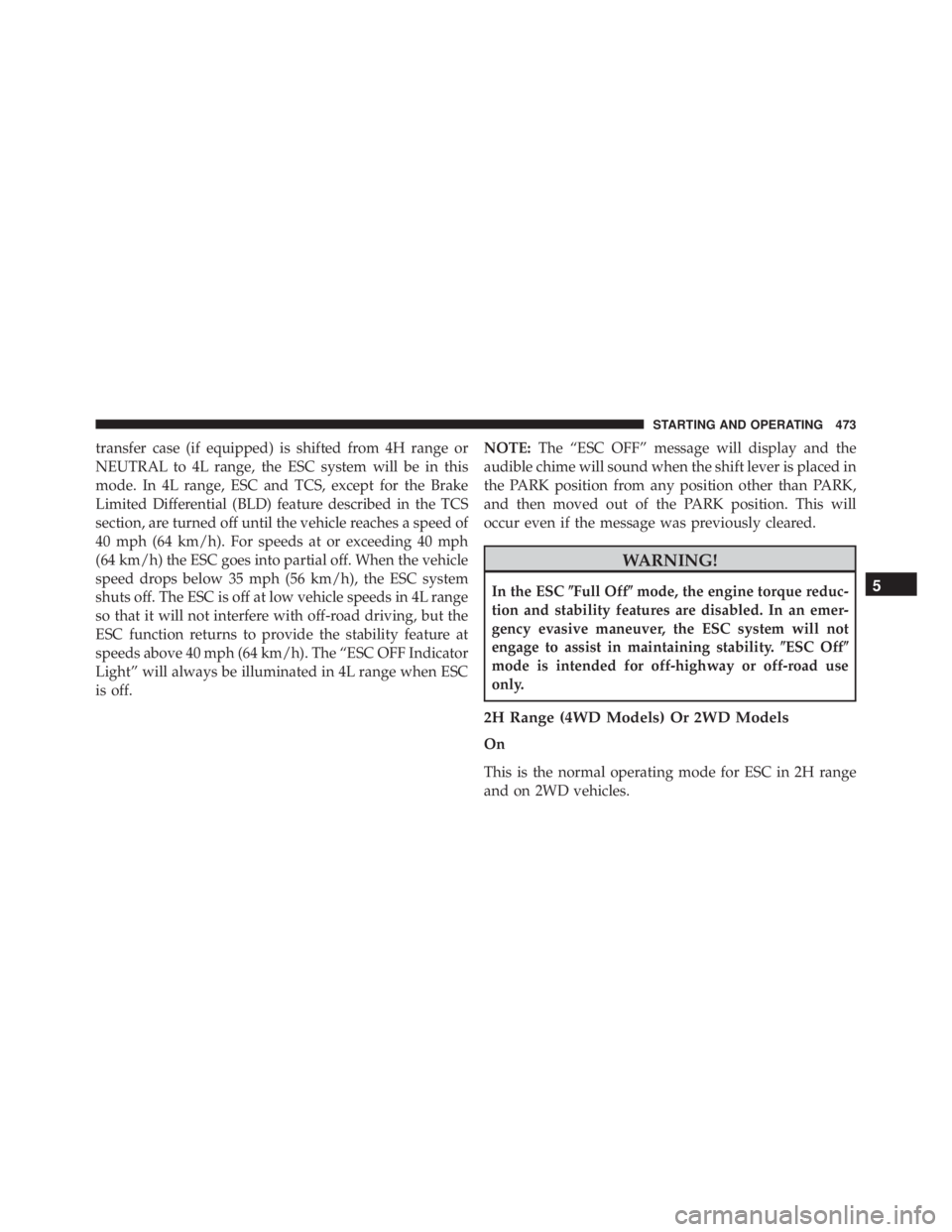
transfer case (if equipped) is shifted from 4H range or
NEUTRAL to 4L range, the ESC system will be in this
mode. In 4L range, ESC and TCS, except for the Brake
Limited Differential (BLD) feature described in the TCS
section, are turned off until the vehicle reaches a speed of
40 mph (64 km/h). For speeds at or exceeding 40 mph
(64 km/h) the ESC goes into partial off. When the vehicle
speed drops below 35 mph (56 km/h), the ESC system
shuts off. The ESC is off at low vehicle speeds in 4L range
so that it will not interfere with off-road driving, but the
ESC function returns to provide the stability feature at
speeds above 40 mph (64 km/h). The “ESC OFF Indicator
Light” will always be illuminated in 4L range when ESC
is off.NOTE:
The “ESC OFF” message will display and the
audible chime will sound when the shift lever is placed in
the PARK position from any position other than PARK,
and then moved out of the PARK position. This will
occur even if the message was previously cleared.
Page 476 of 674
Page 477 of 674
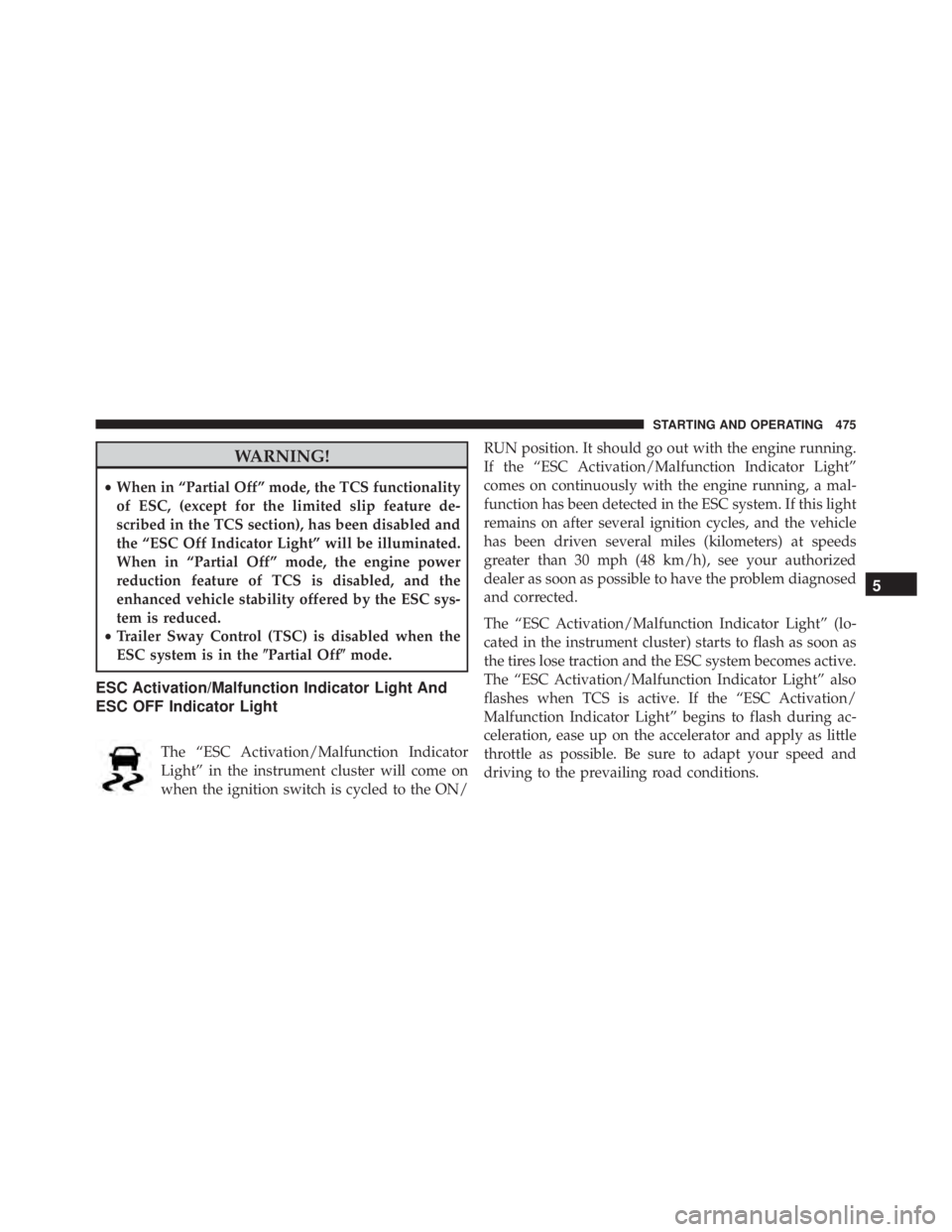
WARNING!
•When in “Partial Off” mode, the TCS functionality
of ESC, (except for the limited slip feature de-
scribed in the TCS section), has been disabled and
the “ESC Off Indicator Light” will be illuminated.
When in “Partial Off” mode, the engine power
reduction feature of TCS is disabled, and the
enhanced vehicle stability offered by the ESC sys-
tem is reduced.
• Trailer Sway Control (TSC) is disabled when the
ESC system is in the �Partial Off�mode.
ESC Activation/Malfunction Indicator Light And
ESC OFF Indicator Light
The “ESC Activation/Malfunction Indicator
Light” in the instrument cluster will come on
when the ignition switch is cycled to the ON/ RUN position. It should go out with the engine running.
If the “ESC Activation/Malfunction Indicator Light”
comes on continuously with the engine running, a mal-
function has been detected in the ESC system. If this light
remains on after several ignition cycles, and the vehicle
has been driven several miles (kilometers) at speeds
greater than 30 mph (48 km/h), see your authorized
dealer as soon as possible to have the problem diagnosed
and corrected.
The “ESC Activation/Malfunction Indicator Light” (lo-
cated in the instrument cluster) starts to flash as soon as
the tires lose traction and the ESC system becomes active.
The “ESC Activation/Malfunction Indicator Light” also
flashes when TCS is active. If the “ESC Activation/
Malfunction Indicator Light” begins to flash during ac-
celeration, ease up on the accelerator and apply as little
throttle as possible. Be sure to adapt your speed and
driving to the prevailing road conditions.
5
STARTING AND OPERATING 475
Page 478 of 674
Page 479 of 674
WARNING!
If TSC activates while driving, slow the vehicle
down, stop at the nearest safe location, and adjust the
trailer load to eliminate trailer sway.
Hill Descent Control (HDC) — If Equipped
HDC is only intended for low speed off-road driving.
HDC maintains vehicle speed while descending hills in
off-road driving conditions by applying the brakes when
necessary.The symbol indicates the status of the Hill
Descent Control (HDC) feature. The lamp will
be on solid when HDC is armed. HDC can only
be armed when the transfer case is in the “4WD
LOW” position and the vehicle speed is less then 30 mph
(48 km/h). If these conditions are not met while attempt-
ing to use the HDC feature, the HDC indicator light will
flash on/off. When enabled, HDC senses the terrain and activates
when the vehicle is descending a hill. HDC speed may be
adjusted by the driver to suit the driving conditions. The
speed corresponds to the transmission gear selected.5
STARTING AND OPERATING 477
Page 480 of 674
Trending: wheel, brake light, fuse, jacking, traction control, power steering fluid, warning light


